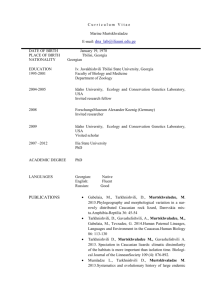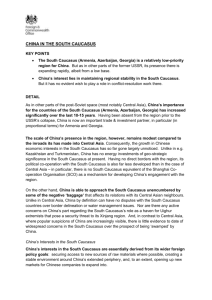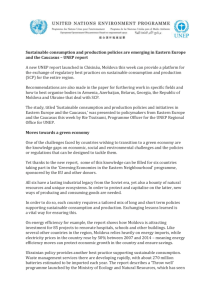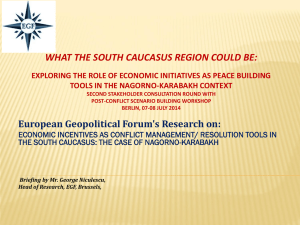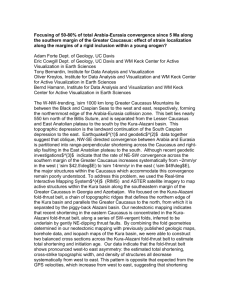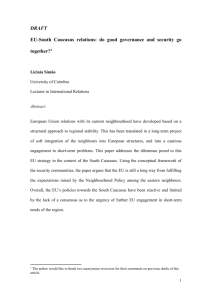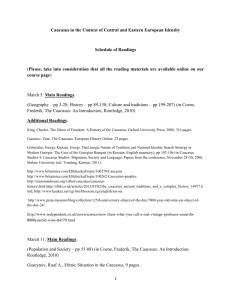papava_On the Possibilities and Prospects for the Formation of an
advertisement
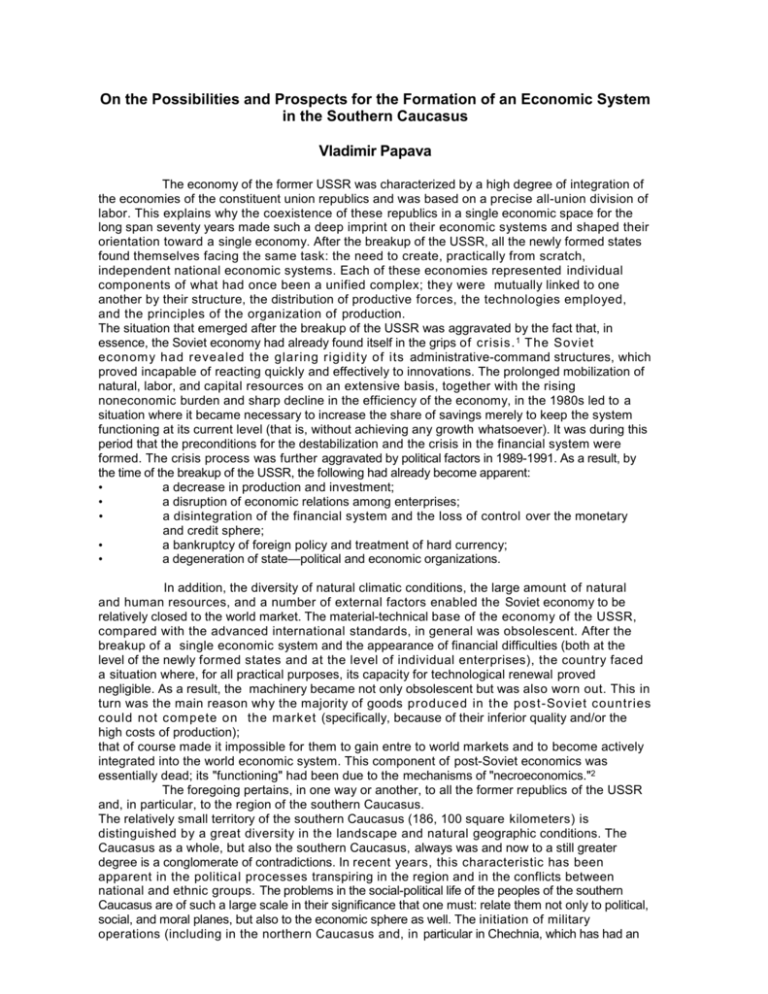
On the Possibilities and Prospects for the Formation of an Economic System in the Southern Caucasus Vladimir Papava The economy of the former USSR was characterized by a high degree of integration of the economies of the constituent union republics and was based on a precise all-union division of labor. This explains why the coexistence of these republics in a single economic space for the long span seventy years made such a deep imprint on their economic systems and shaped their orientation toward a single economy. After the breakup of the USSR, all the newly formed states found themselves facing the same task: the need to create, practically from scratch, independent national economic systems. Each of these economies represented individual components of what had once been a unified complex; they were mutually linked to one another by their structure, the distribution of productive forces, the technologies employed, and the principles of the organization of production. The situation that emerged after the breakup of the USSR was aggravated by the fact that, in essence, the Soviet economy had already found itself in the grips of crisis. 1 The Soviet econom y had revealed the glaring rigidity of its administrative-command structures, which proved incapable of reacting quickly and effectively to innovations. The prolonged mobilization of natural, labor, and capital resources on an extensive basis, together with the rising noneconomic burden and sharp decline in the efficiency of the economy, in the 1980s led to a situation where it became necessary to increase the share of savings merely to keep the system functioning at its current level (that is, without achieving any growth whatsoever). It was during this period that the preconditions for the destabilization and the crisis in the financial system were formed. The crisis process was further aggravated by political factors in 1989-1991. As a result, by the time of the breakup of the USSR, the following had already become apparent: • a decrease in production and investment; • a disruption of economic relations among enterprises; • a disintegration of the financial system and the loss of control over the monetary and credit sphere; • a bankruptcy of foreign policy and treatment of hard currency; • a degeneration of state—political and economic organizations. In addition, the diversity of natural climatic conditions, the large amount of natural and human resources, and a number of external factors enabled the Soviet economy to be relatively closed to the world market. The material-technical base of the economy of the USSR, compared with the advanced international standards, in general was obsolescent. After the breakup of a single economic system and the appearance of financial difficulties (both at the level of the newly formed states and at the level of individual enterprises), the country faced a situation where, for all practical purposes, its capacity for technological renewal proved negligible. As a result, the machinery became not only obsolescent but was also worn out. This in turn was the main reason why the majority of goods produced in the post-Soviet countries could not com pete on the m ark et (specifically, because of their inferior quality and/or the high costs of production); that of course made it impossible for them to gain entre to world markets and to become actively integrated into the world economic system. This component of post-Soviet economics was essentially dead; its "functioning" had been due to the mechanisms of "necroeconomics."2 The foregoing pertains, in one way or another, to all the former republics of the USSR and, in particular, to the region of the southern Caucasus. The relatively small territory of the southern Caucasus (186, 100 square kilometers) is distinguished by a great diversity in the landscape and natural geographic conditions. The Caucasus as a whole, but also the southern Caucasus, always was and now to a still greater degree is a conglomerate of contradictions. In recent years, this characteristic has been apparent in the political processes transpiring in the region and in the conflicts between national and ethnic groups. The problems in the social-political life of the peoples of the southern Caucasus are of such a large scale in their significance that one must: relate them not only to political, social, and moral planes, but also to the economic sphere as well. The initiation of military operations (including in the northern Caucasus and, in particular in Chechnia, which has had an especially negative influence on Georgia) has led to destruction, loss of life, the social problems associated with the presence of a large number of refugees, and the blockade of transportation arteries. All this inevitably had a substantial impact on the economic situation and the realization of production capabilities in the states of the southern Caucasus. As a result of these political, economic, and other factors, practically all the entities of the southern Caucasus-in one or another degree-found themselves cast into a profound crisis, which enveloped all spheres of their activities and led to a sharp contraction of production, to a high level of inflation, and to a decline in the standard of living. In Georgia, for example, the volume of production of the gross domestic product (GDP) decreased between 1989 and 1994 by 4.5-fold; in Azerbaijan the GDP of 1996 was 42 percent lower than it had been in 1990; the economy of Armenia by 1994 was in severe straits (the GDP of 1993 representing only a third of its level in 1989). Beginning in 1994-1995, thanks to the active implementation of reform,3 one can observe a tendency toward stabilization and economic recovery. However, the consequences of the crisis are so profound that they cannot be overcome in a single year; it is necessary here to carry out a radical, constructive domestic economic policy, to find an optimal combination of interests of all entities of this region, and to make an active effort to attract foreign investment. The development of the economy in this or that country, to a large degree, depends on how much one takes into account foreign economic factors in the formulation of a country's economic policy. Of particular significance is the need to take into account the main tendencies in international relations and to find a country's own niche in the world economic system. This must become the foundation for determining the strategic lines of economic development and the top priorities of economic reform in the countries of the southern Caucasus. The economic progress of the states of the southern Caucasus, above all, will be predetermined by the tempo of their integration into the civilized world. If one considers the current condition of the economy and productive potential of the states of the southern Caucasus, the goal of integration cannot be thought to be among those that are easily resolved. To be sure, it is impossible to say that the region of the southern Caucasus, despite the political complications that do exist, is not at all isolated from the rest of the world. First, this re gion is a component of the Commonwealth of Independent States (CIS). 4 Second, Azerbaijan, Armenia, and Georgia are members of the Black Sea Economic Alliance. Third, all three states of the southern Caucasus almost simultaneously signed agreements with the European Union for cooperation and partnership; this laid the basis for bilateral commercial and economic relations with many countries of the world community. However, one cannot see all these aspects of international integration as sufficient to bring about the region's, inclusion into the world market. In the opinion of critical experts, today the CIS is experiencing a certain stagnation with respect to its integration processes. Moreover, for a number of well-known reasons, it is in no position to ensure the introduction of international standards of production; on the contrary, it promotes the formation of limits to the integration processes within the framework of the CIS (in a manner analogous to the closed system of productive cooperation that had characterized the economic system of the USSR).5 The Black Sea Economic Alliance, although possessing great prospects and therefore demanding special attention, nevertheless is still a relatively new inter-state regional organization. For the present, it does not have the requisite level of integration and active interrelations to exert a substantial influence on the economic development of its member-states. Cooperation with the European Union and economically developed European states, at the present time, cannot be realized on the basis of an equal partnership. Rather, here is a process of providing aid in mastering and implementing democratic principles in ordering social and political life and in introducing market mechanisms into the economy. 6 Moreover, the advanced countries of the world for the present are taking a wait-and-see position as they follow the course of events in the southern Caucasus. The view is widespread that the southern Caucasus is, unfortunately, a "hot spot" that lacks sufficient political and economic stability to attract economic partners. At the same time, one must also take into account the fact that the relatively small size of the countries of the southern Caucasus (with a total population that does not exceed 17 million), all things being equal, determines the correspondingly small scale of their markets. If one looks beyond the existing conflicts in the region and examines the theoretical possibility of forming a single market in the southern Caucasus, then even in this idealized case the scale of this market is nonetheless still small and cannot provide a major attraction for substantial investments. This idealized market can be "covered" by the investments being made either in Russia or in Turkey. All this demonstrates the need to find opportunities for mutual assistance among economic entities in the states of the southern Caucasus with respect to laying the preconditions for rapid, stable development. It also shows the need to find opportunities to establish a system of strategic economic partnership (and not simply cooperation) in the southern Caucasus. 7 Only joint (even if, initially, informal) efforts will facilitate the effort to find common spheres for attracting foreign investment to the region. As for the question of attracting large-scale investments to the southern Caucasus, the main task here is the need to reduce the high risk of long-term investments. It is this factor that has made investment in the southern Caucasus so unattractive. At the same time, the region has spheres that could become objects of special interest for foreigner investors. In this respect, it is sufficient to cite the oil of the Caspian basin8 and the Eurasian transportation-communications corridor,9 linking Europe and Asia through the region of Central Asia and the southern Caucasus.10 All this allows one to conclude that the southern Caucasus is acquiring a special function and that many states and leading companies of the world have made it a strategic goal to consolidate their presence in this region. The increase in the rate of economic growth in Azerbaijan can be mainly attributed to the growth in the volume of oil production and to the development of the petroleum refining branch. At the same time, both the problem of developing the oil branch and the future economic development of the entire southern Caucasus, to a large degree, depends on creating the transportation arteries of TRASECA (Transport-Corridor- Europe-Caucasus-Central Asia). TRACECA11 today is viewed as a transit corridor, which will supplement and develop all the existing routes, in the first instance, the European routes. In this regard, it represents an opportunity to link the transportation systems of the Black, Caspian, Adriatic, and Mediterranean Seas. No less important is the task of resolving the question of transporting energy resources through a pipeline system. In particular, the Azerbaijani-Georgian route for shipping oil has become one of the top-priority, large-scale projects in Georgia and has attracted considerable foreign investments. At the same time, the realization of this project creates the preconditions for more active investment in other spheres of the Azerbaijani and Georgian economies. At the same time, this project would not have a future were there not also a parallel project to ship oil from Azerbaijan through Russia. That is because, given the conditions of potential conflict and the fact that the oil pipelines cross through or near to "hot spots," the existence of alternative pipelines is critical. Consequently, this example shows that not only Azerbaijan and Georgia, but in the question of shipping early oil both Georgia and Russia can indirectly be seen as strategic economic partners, even if, unfortunately, Russia for all practical purposes has never acknowledged as much.12 It is particularly important for the economies of Georgia and Armenia that the project for a transportation corridor through Georgia, Armenia, and Iran be realized. Such a corridor is of fundamental significance for the development of a strategic partnership between Georgia and Armenia. In examining the various aspects of economic development of an entire geographic region and the mutual relations of the states located here, it is also necessary to touch upon the question of economic competition between the individual countries in this region. According to the theory of market competition, various levels of competition are foreseen: at the firm level, at the branch level, at the country level, and at the regional level. As a rule, the competitors should be characterized by a more or less identical economic power and identical definition of their economic interests, which in turn determine the conjunction of their economic claims. The competitiveness of a country depends, in the first instance, on how productively it makes use of its natural, labor, material, and financial resources. At the same time, any competition is, to a certain degree, a stimulus for improvement. If there were no international competition, the level of productivity in each individual country would be virtually independent of the situation in other countries. But the international flow of goods and capital represents an opportunity to increase the productivity in exploiting a country's resources, eliminates the need to produce all goods and services on its own, and enables a country to specialize in those branches of the economy and market segments where it is relatively more competitive. Given the foregoing, one can draw the practical conclusion that, in economic terms, for example, Azerbaijan and Georgia are not strategic competitors. This is due to the fact that Azerbaijan has oil and gas, while Georgia has sea access to the ocean and direct borders on Turkey. Moreover, both countries are located on the TRACECA route; each has its own productive potentials, which in a number of cases are unique. All this means that Azerbaijan and Georgia cannot be seen as competitors, but rather are strategic economic partners. Georgia has a vested interest in seeing that Caspian oil and natural gas (and not only these items) are transported to the West across its own territory. That is, simultaneously, in the interests of Azerbaijan, for in this case all possible cargoes from East to West-and vice-versa-will pass through its territory. At the same time, the lack of economic competition between Georgia and Azerbaijan in no way should be seen as causing a lack of stimuli for development. After all, these countries have other country-competitors. But they themselves should be seen as economic partners in interregional competition. The economic partnership of Georgia and Azerbaijan can become a magnet (as, to a certain degree, is already confirmed in practice) for attracting other entities not only to the southern Caucasus, but throughout the entire Caucasus. Unfortunately, however, not all are willing to recognize publicly the advantages of a strategic economic partnership for the region. In turn, a strategic economic partnership is the foundation upon which one can, and should, construct an economic system for the southern Caucasus. 1 For example, see W. Easterly and S. Fisher, "Living on Borrowed Time: Lessons of the Soviet Economy's Collapse, " Transition. The Newsletter about Reforming Economies, 5: 4 (1994). 2 V. Papava, "Necroeconomics-a Phenomenon of the Post-Communist Transition Period, " Problems of Economic Transition, 44: 8 (2001). 3 V.A. Shul'g, cd., Ekonomika SNG: 10 let rcformirovaniia i integratsionnogo razvitiia (Moscow: Finstatinform, 2001); I. Maradian, Geoekonomicheskaia situatsiia v stranakh zakavkazskogo regiona i ekonomicheskaia struktura etikh gosudarstv," Tsentral'naia Aziia i Kavkaz, 2000, no. 1. 4 For example, see D. Matsnev, "Strany Tsentral'noi Azii i Kavkaza v SNG: ekonomicheskii aspekt," Tsentral'naia Aziia i Kavkaz, 2000, no. 1; L.P. Kozik and P.A. Kokhno, SNG: realii i penpektivy (Moscow: Izdatel'skii dom "luridicheskii mir VK). 5 M.B. Olcott, A. Aslund, and S.W. Garnett, Getting It Wrong: Regional Cooperation and the Commonwealth of Independent States (Washington, D.C.: Carnegie Endowment for International Peace, 1999). 6 For example, see A.M. Gegeshidze, "The South Caucasus: Getting Close to Europe?" Marco Polo Magazine, 1999, no. 1. 7 V. Papava and N. Gogatadze, "Prospects for Foreign Investments and Strategic Economic Partnership in the Caucasus," Problems of Economic Transition, 41:5 (1998); V. Papava and N. Kakabadze, "Strategicheskoe ekonomicheskoe partnerstvo na Kavkaze," Zovnishnia torgivlia, 2000, no. 2. 8 F. Asadov, "Neftianye karavany XXI veka na Velikom shelkovom puti: perspektivy Azerbaidzhana i Kazakhstana," Tsentral'naia Aziia i Kavkaz, 2000, no. 6. 9 A. Gegeshidze, "Eshche raz o Velikom shelkovom puti," Tsentral'naia Aziia i Kavkaz, 1999, no. 3(4): 172. 10 A. Martirosian, "Velikii shelkovyi put': etapy vosstanovleniia," Tsentral'naia Aziia i Kavkaz, 2000, no. 6. 11 A. Rondeli, "TRACECA: A Tool for Regional Cooperation in the Caucasus," Marco Polo Magazine, 1999, no. 1. 12 R.M. Avakov and A.G. Lisov, eds., Rossiia i Zakavkaz'ea: realii nezavisimosti i novoe partnerstvo (Moscow: ZAO "Finstatinform," 2000).

